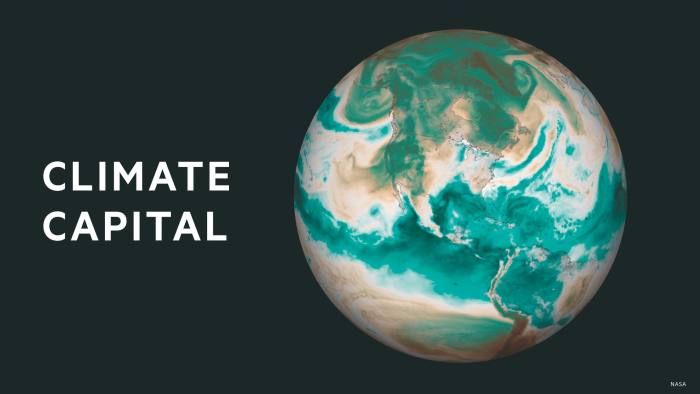When the COP27 climate talks begin next month in Egypt, there will be dozens of depressing data points for delegates to consider. Here is one that has largely gone unnoticed: between 2019 and 2021, there were only $14bn of so-called climate “blended finance” deals — structures that use public money to de-risk green investments — for poor countries.
This was less than half the volume seen in the previous three years. Yes, you read that right: even amid renewed calls to fight climate change around the world, blended finance has shrivelled in a most “disappointing and unexpected” way, says Joan Larrea, head of the Convergence group that collected the data.
This might not alarm non-financiers. After all, the phrase “blended finance” tends to sound worthy-but-dull, the financial policy equivalent of spinach. It never graces the lips — or placards — of activists such as Greta Thunberg.
But, as next month’s meeting will show, developing countries feel increasingly angry about the lack of support from wealthier nations in tackling climate change. If the west wants to counter this, it needs to rapidly unclog the blended finance pipeline in what could be the single most sensible way to help.
Right now, global climate finance is in a bifurcated state of flood and drought. Parts of the environmental ecosystem are drowning in private funding, sending green asset valuations sky high. Financial groups such as Brookfield, General Catalyst and TPG (to name but a few) have raised tens of billions to support green projects.
Meanwhile, mainstream environmental, social and governance funds have swelled, despite the rightwing anti-ESG backlash. This is likely to continue, given that the younger generations in the west care more about green issues than their elders, and are set to inherit many trillions from them.
But the developing world faces a drought. Poor nations urgently need funding to switch from dirty activities (such as burning coal) to green equivalents. Yet western private sector capital currently shies away. This is partly because of political and currency risks but it also reflects a shortage of credit data, and the fact that developing country projects tend to be too small — and too opaque — to meet the criteria of the investment funds.
Until now, efforts to plug this gap have mostly focused on public or philanthropic funds. At the upcoming COP27 debates, for example, there will be demands for more climate aid from wealthy countries (which seems unlikely to materialise given that rich nations, lamentably, have not yet fulfilled a 2015 pledge for $100bn annual help.)
There will also be demands for the multilateral development banks (MDBs), such as the World Bank, to extend dramatically more green loans. Mia Mottley, the Barbadian premier, wants more than $100bn in such reserves to be repurposed for this cause with a further $650bn in new issuance for clean-energy developments.
The World Bank has so far refused to do this, since its leaders fear losing their cherished AAA credit rating or having to change the bank charter. But encouragingly, US climate envoy John Kerry told me this week that the US, which is the bank’s biggest shareholder, also wants reform. “We think that a significant increase in concessionary finance [from MDBs] could be created by virtue of being more creative,” he says.
Unfortunately, the unpalatable fact is that, even if MDB funding or aid doubles, it will not be enough. After all, the OECD reckons that $2tn a year is needed for sustainable development. Total western aid in 2021 was $179bn.
Climate Capital

Where climate change meets business, markets and politics. Explore the FT’s coverage here.
Are you curious about the FT’s environmental sustainability commitments? Find out more about our science-based targets here
Hence why blended finance matters — enormously. The beauty of this concept is leverage: if a small pot of MDB or western aid provides the first-loss tranche for green investment projects, it could attract a much larger dollop of private sector capital. And if MDBs participated in such projects, they might be persuaded to share their all-important credit data on emerging markets and roll lots of small projects into larger pools of investible structures.
These points matter enormously for investors, and could be one way to divert the flood of money in green finance to the parched corners of the system that are currently ignored.
Small experiments in this direction have occurred but, as the Convergence data shows, they have not yet caught on. That is partly because the MDBs tend to be conservative. But it is also due to a “silo” problem: it is very hard for different public, private and non-profit groups to collaborate in the existing structures, particularly across borders.
Might this change? Possibly, if there is clear leadership from one player, such as America. This month, Janet Yellen, US Treasury secretary, startled observers by calling for a radical overhaul of green finance structures. Kerry tells me that entities such as the Rockefeller Foundation are conducting blended finance test projects. An experimental new blended finance entity called ILX has been created in the Netherlands. Others are mooted.
But far more needs to be done and far faster. Above all, western countries need to lean on the MDBs to get on board. Without more funding, the anger of developing nations will only swell — along with the climate risks and pain. That will hurt us all, rich and poor alike.


Comments are closed, but trackbacks and pingbacks are open.